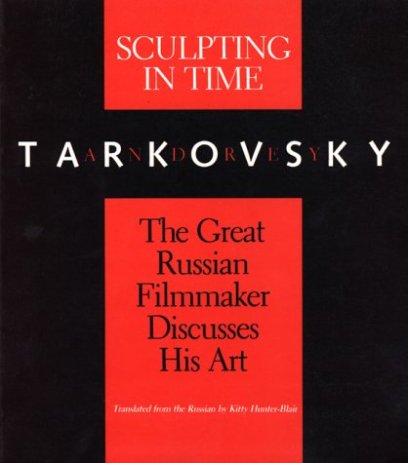art
Sculpting In Time
by Andrei Tarkovsky
Overall: Definitely a book to put on your shelves!
Cinema should be a means of exploring the most complex problems of our time, as vital as those which for centuries have been the subject of literature, music, and painting.
History
Sculpting in Time by Andrei Tarkovsky is one of the most brilliant essays that I have ever read. Not only is it an excellent, straight-from-the mouth understanding of the films from Tarkovsky himself, this book opens your eyes to philosophy, religion, and art which is understood by the brilliant director.
Andrei Arsenyevich Tarkovsky was born in 1932 to Maria Vishnyakova and the famous Russian poet Arseny Alexandrovich Tarkovksy. Andrei was educated in cinema and film studies.
Andrei’s first film was Ivan’s Childhood (1962) which came from a story written by Bogomolov. In Andrei’s interpretation, Ivan’s Childhood is a war film that shows the character’s forced life within war-filled Russia. The dark and gritty nature that mixes with the purity and optimistic dream sequences from Ivan make up this baneful film.
Andrei’s second film, Andrei Rublev (1966) is a biopic of the famous titular iconographer. Andrei covers the duality and psychological effects of Andrei’s burden in his understanding of his relationship with God in medieval Russia during the Tartar invasions and Russia’s transition from a pagan society to Orthodoxy. The film is one of Andrei’s more graphic, gritty, but also the beginning of Andrei’s filmography career that focuses on religion and spirituality.
The fourth film, Solaris (1972), is a loose narrative from the Stanislaw Lem novel of the same name. This is Andrei’s first film that is in the science-fiction and horror genre. More psychological in nature, the main character–a psychologist named Kris–tries to understand the reality created by mysterious planet Solaris and struggles with the power that the human mind can do. Mirror (1975) is Andrei’s more personal film. It incorporates poetry written by Andrei’s father and even his own mother makes a cameo. The film revolves around the rhythm and timing of childhood memories, relationships, dreams, and the new (at the time) television program style of interview and newsreel footage.Andrei’s fifth film, and my personal favorite, Stalker (1979) is one of Tarkovsky’s well-known films. This science fiction, based on the novel Roadside Picnic (it is a loose narration), is an allegorical film making criticism on the modern world and the modern desires in which the Stalker suffers as he bears the burden of guiding visitors into the dangerous Zone. During filming of this film, it is alleged that Tarkovsky as well as many of the principal actors were exposed to radiation which inevitably led to Tarkovsky’s development of cancer.
Andrei emigrated to Paris due to the strict censorship restrictions on his films in the Soviet Union and out of Russia is where he filmed his final two films: Nostalgia (1983) in Italy and The Sacrifice (1986) in Sweden. Nostalgia relates to Tarkovksy’s emigration in the main character feels homesickness and the longing for his country and the things that made him human (” Я снимал фильм глубоко русский во всех его аспектах: моральных, нравственных, политических и эмоциональных…”). In The Sacrifice, the film coincides with the events of Chernobyl in the Ukraine, and the main character must try to save the destroying world by giving up the things that he loves. Andrei Tarkovsky died in December of 1986 shortly after filming in Paris. His diaries were published posthumously.Sculpting in Time is an excellent collection of Andrei’s thoughts and opinions of his films and the meaning and history behind the films. Despite some of the dark themes that Tarkovsky covers in his films, the book is uplifting, inspirational, and praises human life and spirituality. While Tarkovsky is highly religious, he covers spirituality on a poetic and universal level, relating to people in a style that is known by everyone: art.
Люблю глаза твои, мой друг,
С игрой их пламенно-чудесной,
Когра из приподыменшь вдруг
И словно молнией небесной
Окинешь бегло целый круг…
Tarkovsky also describes the nuances of filmmaking which includes mise en scene and the director’s relationship with time, rhythm, and editing to create a world that the audience can both immerse themselves in and become emotionally involved. The opinion of the author is similar to Dostoevsky, the commitment to passion in both the actors and the director himself.
And the moment of death is also the death of individual time: the life of a human being becomes inaccessible to the feelings of those remaining alive, dead for those around him.
If you are an artist of any type, you would benefit greatly to reading this book to inspire you and any medium that you choose to excel in.
One thing is certain: a masterpiece only comes into being when the artist is totally sincere in his treatment of his material.
Whether or not you have seen the films, the beautiful pictures of Tarkovksy behind the scenes, and many still shots of all of his films are a superb resource. I believe that all film lovers and anyone who loves/writes poetry should have this book on their shelf.
Mother came and beckoned me, and flew away…
Watch some of Tarkovsky’s films (use CC for subtitles)
Stalker Pt 1
Stalker Pt 2
Andrei Rublev Pt 1 (extremely graphic)
Andrei Rublev Pt 2 (extremely graphic)
Не сни, не спи, художникне предавайся сну…ты вечности заложник,у временив плену

